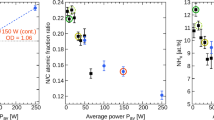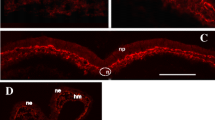Abstract
The levels of glucose transporters (GLUTs), specifically GLUT3 and GLUT1, increased dramatically in PC12 cells that were cultured on suitable adhesion substrata (poly-l-lysine [PLL]) and induced to differentiate with nerve growth factor (NGF). Closer examination of this response revealed that: (1) cellular attachment to PLL was sufficient to stimulate the increase in GLUT immunoreactivity, and (2) NGF alone was not effective unless the cells were cultured on PLL-treated surfaces. The response to PLL was detected as early as 4 hr after plating the cells and peaked within 24–48 hr. Other adhesion substrata, such as collagen and poly-l-ornithine, evoked a similar response, although the latter polymer was far less effective. The increase in GLUTs appeared to result from an accumulation of existing transporters because this response was not blocked by inhibiting protein synthesis. Cellular adhesion to PLL was also accompanied by a rapid activation of glucose metabolism. Thus, specific recognition of the adhesion substratum not only provides a context for cell attachment, but also elicits important functional changes in GLUT activity.
Similar content being viewed by others
REFERENCES
Kety, S. S. 1957. The general metabolism of the brain in vivo. Pages 221-236, in Richter, D. (ed.) Metabolism of the Nervous System. Pergammon Press, London.
Sokoloff, L. 1976. Circulation and energy metabolism of the brain. Pages 388-413 in Siegel, G. J., Albers, R. W., Katzman, R., and Agranoff, B. W. (eds.) Basic Neurochemistry. Little, Brown and Co., Boston.
Lund-Andersen, H. 1979. Transport of glucose from blood to brain. Physiol. Rev. 59:305-352.
Kayano, T., Fukumoto, H., Eddy, R. L., Fan, Y.-S., Byers, M. G., Shows, T. B., and Bell, G. I. 1988. Evidence for a family of transporter-like proteins. Sequence and gene localization of a protein expressed in fetal skeletal muscle and other tissues. J. Biol. Chem. 263:15245-15248.
Mueckler, M. 1990. Family of glucose-transporter genes. Implications for glucose homeostasis and diabetes. Diabetes 39:6-11.
Klip, A., Tsakiridis, T., Marette, A., and Ortiz, P. A. 1994. Regulation of expression of glucose transporters by glucose: A review of studies in vivo and in cell cultures. FASEB J. 8:43-53.
Maher, F., Davies-Hill, T. M., Lysko, P. G., Henneberry, R. C., and Simpson, I. A. 1991. Expression of two glucose transporters, GLUT1 and GLUT3, in cultured cerebellar neurons: Evidence for neuron-specific expression of GLUT3. Mol. Cell. Neurosci. 2:351-360.
Yano, H., Seino, Y., Inagaki, N., Hinokio, Y., Yamamoto, T., Yasuda, K., Masuda, K., Someya, Y., and Imura, H. 1991. Tissue distribution and species difference of the brain type glucose transporter (GLUT3). Biochem. Biophys. Res. Comm. 174:470-477.
Nagamatsu, S., Kornhauser, J. M., Burant, C. F., Seino, S., Mayo, K. E., and Bell, G. I. 1992. Glucose transporter expression in brain. cDNA sequence of mouse GLUT3, the brain facilitative glucose transporter isoform, and identification of sites of expression by in situ hybridization. J. Biol. Chem. 267:467-472.
Nagamatsu, S., Sawa, H., Nakamichi, Y., Katahira, H., and Inoue, N. 1994. Developmental expression of GLUT3 glucose transporter in the rat brain. FEBS Lett. 346:161-164.
Vannucci, S. J., Seaman, L. B., Brucklacher, R. M., and Vannucci, R. C. 1994. Glucose transport in developing rat brain: Glucose transporter proteins, rate constants and cerebral glucose utilization. Mol. Cell. Biochem. 140:177-184.
Hogan, A., Heyner, S., Charron, M. J., Copeland, N. G., Gilbert, D. J., Jenkins, N. A., Thorens, B., and Schultz, G. A. 1991. Glucose transporter gene expression in early mouse embryos. Development 113:363-372.
Smith, D. E., and Gridley, T. 1992. Differential screening of a PCR-generated mouse embryo cDNA library: glucose transporters are differentially expressed in early postimplantation mouse embryos. Development 116:555-561.
Takao, Y., Akazawa, S., Matsumoto, K., Takino, H., Akazawa, M., Trocino, R. A., Maeda, Y., Okuno, S., Kawasaki, E., Uotani, S., Yokota, A., and Nagataki, S. 1993. Glucose transporter gene expression in rat conceptus during high glucose culture. Diabetologia 36:696-706.
Shepard, T. H., Tanimura, T., and Robkin, M. A. 1970. Energy metabolism in early mammalian embryos. Dev. Biol. Suppl. 4:42-58.
Ellington, S. K. 1987. Development of rat embryos cultured in glucose-deficient media. Diabetes 36:1372-1378.
Vannucci, S. J. 1994. Developmental expression of GLUT1 and GLUT3 glucose transporters in rat brain. J. Neurochem. 62:240-246.
Hawkins, R. A., Williamson, D. H., and Krebs, H. A. 1971. Ketone-body utilization by adult and suckling rat brain in vivo. Biochem. J. 122:13-18.
Sokoloff, L. 1973. Metabolism of ketone bodies by the brain. Annu. Rev. Med. 24:271-280.
Yavin, E., and Yavin, Z. 1974. Attachment and culture of dissociated cells from rat embryo cerebral hemispheres on polylysinecoated surface. J. Cell. Biol. 62:540-546.
Letourneau, P. C. 1975. Possible roles for cell-to-substratum adhesion in neuronal morphogenesis. Dev. Biol. 44:77-91.
Turner, D. C., Flier, L. A., and Carbonetto, S. 1987. Magnesium-dependent attachment and neurite outgrowth by PC12 cells on collagen and laminin substrata. Dev. Biol. 121:510-525.
Angeletti, P. U., Luizzi, A., Levi-Montalcini, R., and Gandini-Attardi, D. 1964. Effect of a nerve growth factor on glucose metabolism by sympathetic and sensory nerve cells. Biochim. Biophys. Acta 90:445-450.
Cohen, S. 1959. Purification and metabolic effects of a nerve growth-promoting protein from snake venom. J. Biol. Chem. 234:1129-1137.
Dwyer, D. S., Liu, Y., Miao, S., and Bradley, R. J. 1996. Neuronal differentiation in PC12 cells is accompanied by diminished inducibility of Hsp70 and Hsp60 in response to heat and ethanol. Neurochem. Res. 21:659-666.
Greene, L. A., and Tischler, A. S. 1976. Establishment of a noradrenergic clonal line of rat adrenal pheochromocytoma cells which respond to nerve growth factor. Proc. Natl. Acad. Sci. USA 73:2424-2428.
Fisher, M. D., and Frost, S. C. 1996. Translocation of GLUT1 does not account for elevated glucose transport in glucose-deprived 3T3-L1 adipocytes. J. Biol. Chem. 271:11806-11809.
Simpson, I. A., Chundu, K. R., Davies-Hill, T., Honer, W. G., and Davies, P. 1994. Decreased concentrations of GLUT1 and GLUT3 glucose transporters in the brains of patients with Alzheimer's disease. Ann. Neurol. 35:546-551.
Christopher, W. C., Colby, W. W., and Ullrey, D. 1976. Derepression and carrier turnover: evidence for two distinct mechanisms of hexose transport regulation in animal cells. J. Cell. Physiol. 89:683-692.
Yamada, K., Tillotson, L. G., and Isselbacher, K. J. 1983. Regulation of hexose carriers in chicken embryo fibroblasts. Effect of glucose starvation and role of protein synthesis. J. Biol. Chem. 258:9786-9792.
Haspel, H. C., Wilk, E. W., Birnbaum, M. J., Cushman, S. W., and Rosen, O. M. 1986. Glucose deprivation and hexose transporter polypeptides of murine fibroblasts. J. Biol. Chem. 261:6778-6789.
Mueckler, M. 1994. Facilitative glucose transporters. Eur. J. Biochem. 219:713-725.
Rosen, O. M., Smith, C. J., Fung, C., and Rubin, C. S. 1978. Development of hormone receptors and hormone responsiveness in vitro. Effect of prolonged insulin treatment on hexose uptake in 3T3-L1 adipocytes. J. Biol. Chem. 253:7579-7583.
Kletzien, R. F., and Perdue, J. F. 1974. Sugar transport in chick embryo fibroblasts. II. Alterations in transport following transformation by a temperature-sensitive mutant of the Rous sarcoma virus. J. Biol. Chem. 249:3375-3382.
Birnbaum, M. J., Haspel, H. C., and Rosen, O. M. 1987. Transformation of rat fibroblasts by FSV rapidly increases glucose transporter gene transcription. Science 235:1495-1497.
Flier, J. S., Mueckler, M., Usher, P., and Lodish, H. F. 1987. Elevated levels of glucose transport and transporter messenger RNA are induced by ras and src oncogenes. Science 235:1492-1495.
Rollins, B. J., Morrison, E. D., Usher, P., and Flier, J. S. 1988. Platelet-derived growth factor regulates glucose transporter expression. J. Biol. Chem. 263:16523-16526.
Hiraki, Y., Rosen, O. M., and Birnbaum, M. J. 1988. Growth factors rapidly induced expression of the glucose transporter gene. J. Biol. Chem. 263:13655-13662.
van Putten, J. P. M., and Krans, H. M. J. 1985. Glucose as a regulator of insulin-sensitive hexose uptake in 3T3 adipocytes. J. Biol. Chem. 260:7996-8001.
Tessier-Lavigne, M., and Goodman, C. 1996. The molecular biology of axon guidance. Science 274:1123-1133.
Ortiz, P. A., Honkanen, R. A., Klingman, D. E., and Haspel, H. C. 1992. Regulation of the functional expression of hexose transporter GLUT-1 by glucose in murine fibroblasts: role of lysosomal degradation. Biochemistry 31:5386-5393.
Schirmer, E. C., Farooqui, J., Polak, P. E., Szuchet, S. 1994. GRASP: A novel heparin-binding serum glycoprotein that mediates oligodendrocyte-substratum adhesion. J. Neurosci. Res. 39:457-473.
Ryser, H. J.-P., Hancock, R. 1965. Histones and basic polyamino acids stimulate the uptake of albumin by tumor cells in culture. Science 150:501-503.
Chang, S.-W., Westcott, J. Y., Henson, J. E., and Voelkel, N. F. 1987. Pulmonary vascular injury by polycations in perfused rat lungs. J. Appl. Physiol. 62:1932-1943.
Fromm, J. R., Hileman, R. E., Caldwell, E. E. O., Weiler, J. M., Linhardt, R. J. 1995. Differences in the interaction of heparin with arginine and lysine and the importance of these basic amino acids in the binding of heparin to acidic fibroblast growth factor. Arch. Biochem. Biophys. 323:279-287.
Wang, R., Kobayashi, R., and Bishop, J. M. 1996. Cellular adherence elicits ligand-independent activation of the Met cell-surface receptor. Proc. Natl. Acad. Sci. USA 93:8425-8430.
Author information
Authors and Affiliations
Rights and permissions
About this article
Cite this article
Dwyer, D.S., Pinkofsky, H.B., Liu, Y. et al. Attachment of PC12 Cells to Adhesion Substratum Induces the Accumulation of Glucose Transporters (GLUTs) and Stimulates Glucose Metabolism. Neurochem Res 23, 1107–1116 (1998). https://doi.org/10.1023/A:1020768321358
Issue Date:
DOI: https://doi.org/10.1023/A:1020768321358




